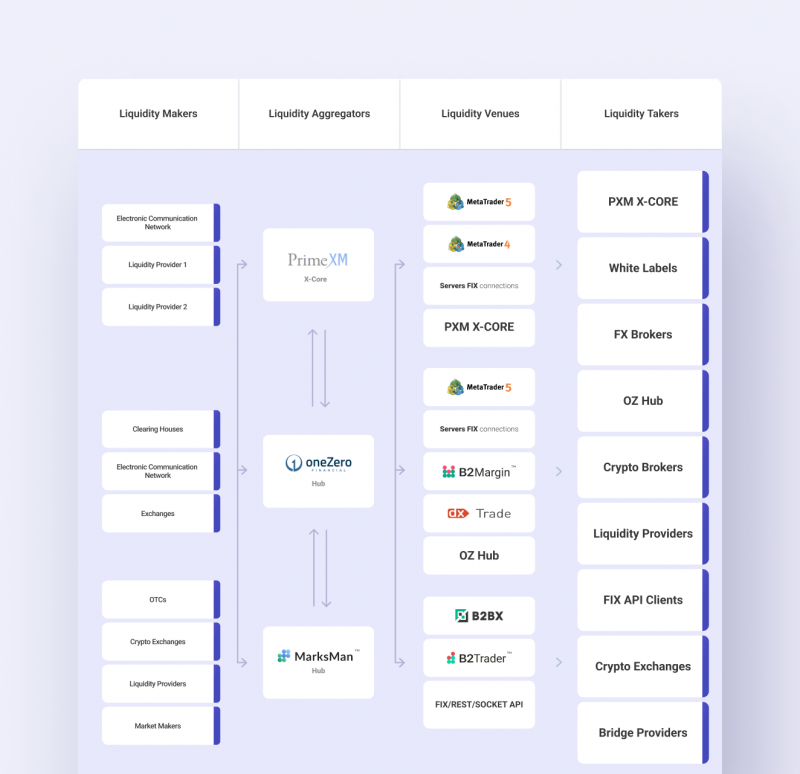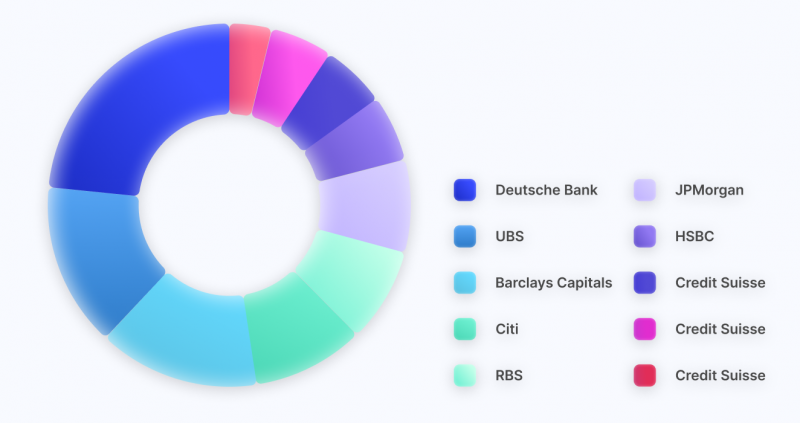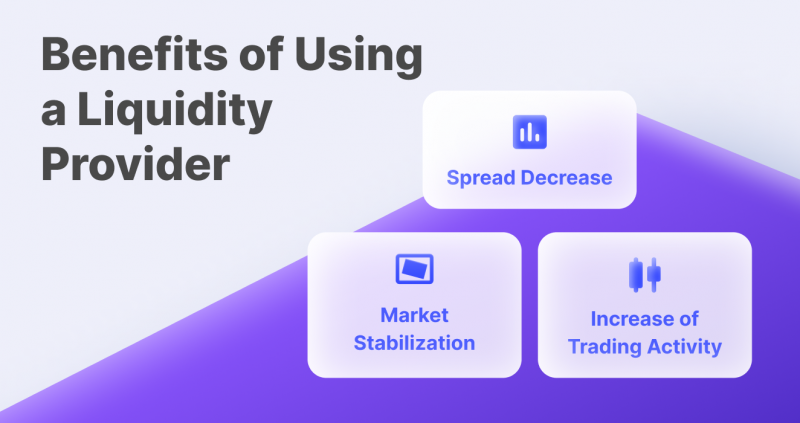How Do Liquidity Providers Work?

Liquidity providers are fundamental for the success of electronic trading in today’s financial market, since they ensure a steady supply of liquidity. This indicator reflects how quickly an instrument can be turned into cash without fluctuating its current price. There are many companies offering liquidity services for any financial market, be it crypto or Forex. But how do they work, and how do they offer liquidity to the market?
This article will help to understand what liquidity providers are, how they generate liquidity for financial markets and what are the main advantages of cooperation with these companies that give a helping hand to business.
What are Liquidity Providers?
Liquidity providers (or liquidity suppliers) are financial entities, the main task of which is to increase liquidity on the trading platform. This is done by placing numerous limit orders in the order book, thereby maintaining the balance of the market in case a large volume of any financial instrument is bought and sold. Increased liquidity reduces the spread (which is expressed as a dissimilarity between the last buy price and the last sell price), as well as trading costs, positively affecting trading on the financial market.

Both crypto and Forex brokerages, especially with direct transaction processing (STP), try to partner with many large liquidity providers to maintain adequate liquidity and prices. Most often, the liquidity supplier is a large financial entity (such as banks) that trades financial instruments on a large scale. In other words, they dispose of such large amounts of money that market participants, when selling their assets, are likely to choose to buy from them.
Thanks to liquidity providers, there is always a buyer and a seller in the market. Sometimes there are cases when a broker can sell assets without transferring the transaction to a liquidity provider. In other words, when you make a purchase, you are not buying from the seller to whom your broker has sent the transaction, but from your broker. These brokers are called “market makers,” representing counterparties. In the crypto market, there are also AMMs (Automated Market Makers) – a software algorithm to control the liquidity (or dry powder) and pricing of crypto-assets on decentralized exchanges.

Provider of liquidity is the large market participant, which unites funds and financial institutions, as well as the world’s largest banks, in a network, forming a pool of liquidity or quotations formed in the price flow for smaller market participants – dealing centers and brokers. Large organizations and banks, which form any financial market with its liquidity, are considered to be the suppliers of quotations. Due to this, the big players unite and can transmit the market quotations to their clients – brokers in the retail market. At the moment, Deutsche Bank, acting also as a retail and investment bank, is considered the largest liquidity provider in the financial markets.

In a decentralized crypto market, the constant buying and selling of currencies requires large reserves of various assets to facilitate retail transactions. These reserves are created by users who provide liquidity in exchange for a share of transaction fees. This commission is generated by exchangers and is typically < 1% of each transaction.
Users who choose to invest their assets in such reserves (or liquidity pools) are called liquidity providers. They can choose how much of a particular asset they would like to invest in the pool, and receive a liquidity provider token, or LP, for their deposit.
Key Takeaways
- Liquidity providers are international entities working in the field of finance, the main task of which is to combine a broker or exchange with traders and investors, thus increasing the market’s liquidity by placing limit orders in the order book.
- Most often, liquidity providers are huge entities in the financial sector such as banks, hedge bonds, large institutional investors and companies that trade financial instruments on a large scale.
How Do Liquidity Providers Generate Liquidity in the Market?
As a result of modern technology, many areas of human activity, including trading on the market, have become simpler. The aggregation process is now conducted automatically and rapidly by software, which is responsible for creating liquidity. Essentially, a liquidity aggregator is software that assists brokers in obtaining the best bids from a variety of liquidity providers at the lowest possible prices due to liquidity pools.
As soon as a trader sends a market order, that order will be executed immediately. It should be noted that if the order is small, it is likely to be “overlapped” by the broker’s clients (usually large Forex brokers) at their expense. Liquidity providers will only accept 0.1 lot from brokers with clients on the other end of the deal. The liquidity provider can generate the order in a larger order pool and send it to the counterparty as soon as it is generated if the order is large. If the counterparty cannot be found (which happens very rarely), he will, if possible, forward the transaction to one of his Tier 2 or ECN pools. As a result, if there is no suitable counterparty available at the present moment in time for the current volume, your order will “slip” if the deal is executed at the nearest possible price at this time. However, the transaction will be carried out so quickly that you will not feel the difference between your transaction with the broker’s client and your transaction with the provider.
The FIX (Financial Information Exchange) protocol is used to aggregate client limit orders. There are two types of order execution that can be performed on this system: FOK and IOC. FOK (Fill Or Kill) execution means that an order is executed at a given price as soon as a liquidity provider offers the same price and volume as the order. It is not possible to choose another option. With IOC (Immediate Or Cancel), the order may be executed fully or partially at a given price and the remaining portion at a different price. Due to the fact that small brokers work through them, liquidity aggregators are sometimes also referred to as providers. The brokers in this category are called STP (Straight Through Processing).
Market prices move until buying volume exceeds selling volume in an effort to find equilibrium. Lack of liquidity manifests on the chart as weak volatility or a number of non-overlapping gaps, for instance, if the interest is not paid (the seller is unable to find a buyer). Slippage, spread widening, and transactions at loss-making prices are just a few issues that this market faces. Because of this, liquidity providers play a crucial part in the process of trading on all financial markets, not only the Forex market.
The term “market maker” is related to players who “make the market” – i.e., banks, funds, and other institutions, while liquidity providers act as mediators between brokers and market makers.
Benefits of Using a Liquidity Provider

Now that you know what liquidity providers are and how they generate liquidity in different financial markets, it’s time to find out what strengths they have. Let’s consider the main ones.
Spread Decrease
Liquidity supplying firms help to reduce the spread in the market. The spread usually has much less volatility than individual instruments because the two instruments are influenced by the same market factors. The two instruments usually correlate with each other – their prices move up and down in a similar way. Thus, a short position on the spread hedges a long position on the spread. As a result, the margin requirement for the spread is usually much smaller than the combined margin requirements of two separate futures contracts.
Market Stabilization
Due to the fact that quite often there appears imbalance in the process of trading a particular asset, which is expressed in the fact that buying or selling is carried out in large volumes due to the so-called whales – investors with large amounts of capital – the price of the asset can change rapidly, which creates a dangerous situation for many market participants, especially for those who are engaged in margin trading. Liquidity providers help to avoid this by supplying liquidity to the distinct markets and thus compensating large deals of whales in order to keep the price of financial assets stable.
Increase of Trading Activity
Trading activity in the market is a key indicator of liquidity. At the same time, high liquidity helps to maintain a high level of trading, because as a rule, traders on the market are willing to trade instruments that can be easily bought or sold without a significant spread and slippage, which appears as a result of low activity. Therefore, liquidity providers help to increase trading activity by increasing the trading volume in the order book in the form of pending orders, which attract market participants to trade.
Conclusion
To summarize, electronic trading has undergone many different changes in the course of its development – from the styles traders use to earn money, and to the electronic systems that are designed to collate orders. Nevertheless, there are some things that remain unchanged, and liquidity providers are one of those important market participants whose role is of high importance to supply liquidity regardless of market conditions and the type of trading instruments used for trading, thereby helping to keep liquid markets in times of high volatility and economic crises.
FAQ
What does a Liquidity provider do in financial markets?
A Liquidity provider supplies steady market depth, making it easier to buy and sell assets at fair, consistent prices.
How can working with a Liquidity provider benefit a broker?
Partnering with a Liquidity provider helps reduce spreads, boost trade execution speed, and improve overall client satisfaction.
Why is a Liquidity provider important during volatile market conditions?
When markets get turbulent, a Liquidity provider ensures steady pricing and minimizes sudden price jumps, maintaining stability.
Recommended articles
By clicking “Subscribe”, you agree to the Privacy Policy. The information you provide will not be disclosed or shared with others.
Recent news
Our team will present the solution, demonstrate demo-cases, and provide a commercial offer









